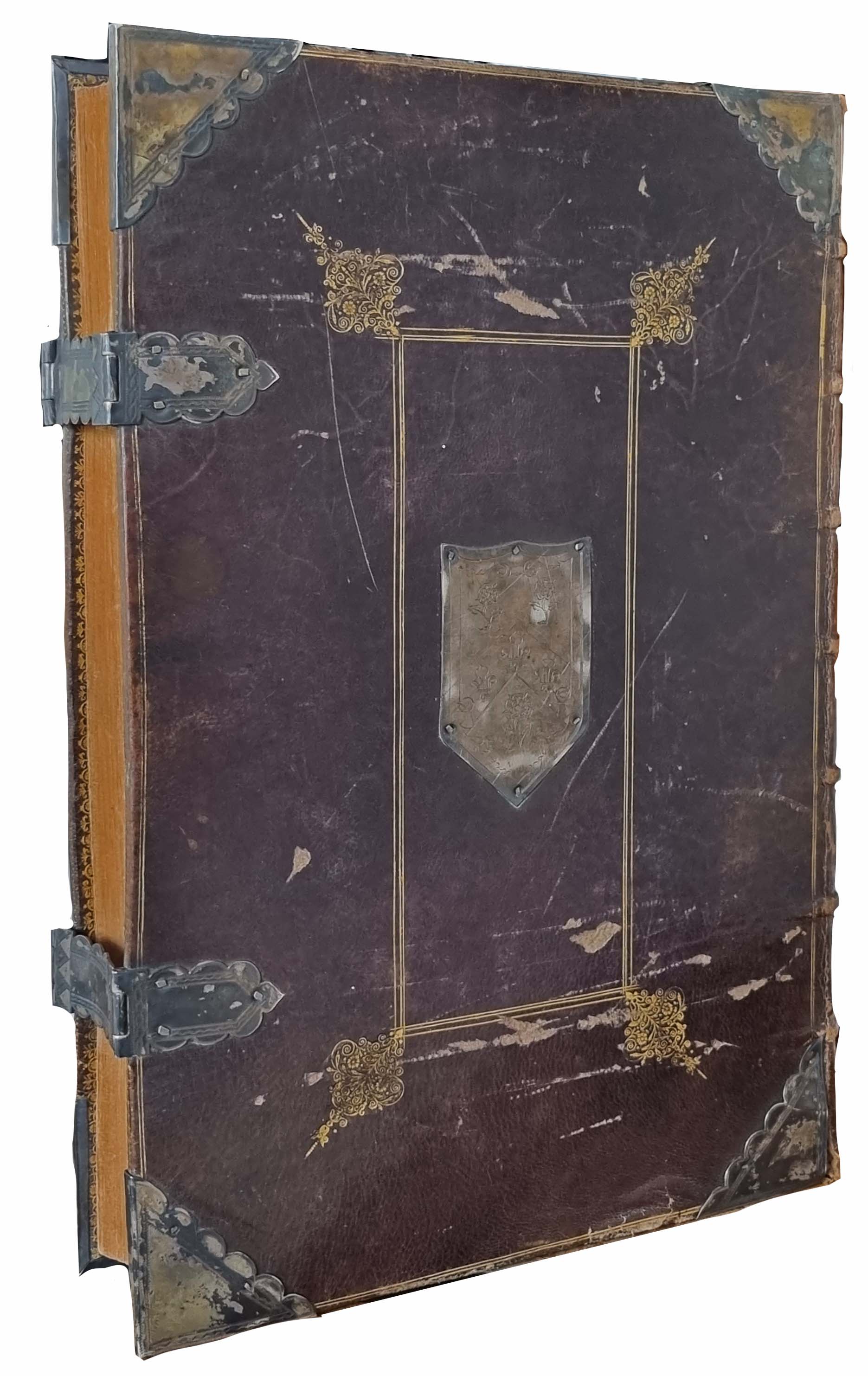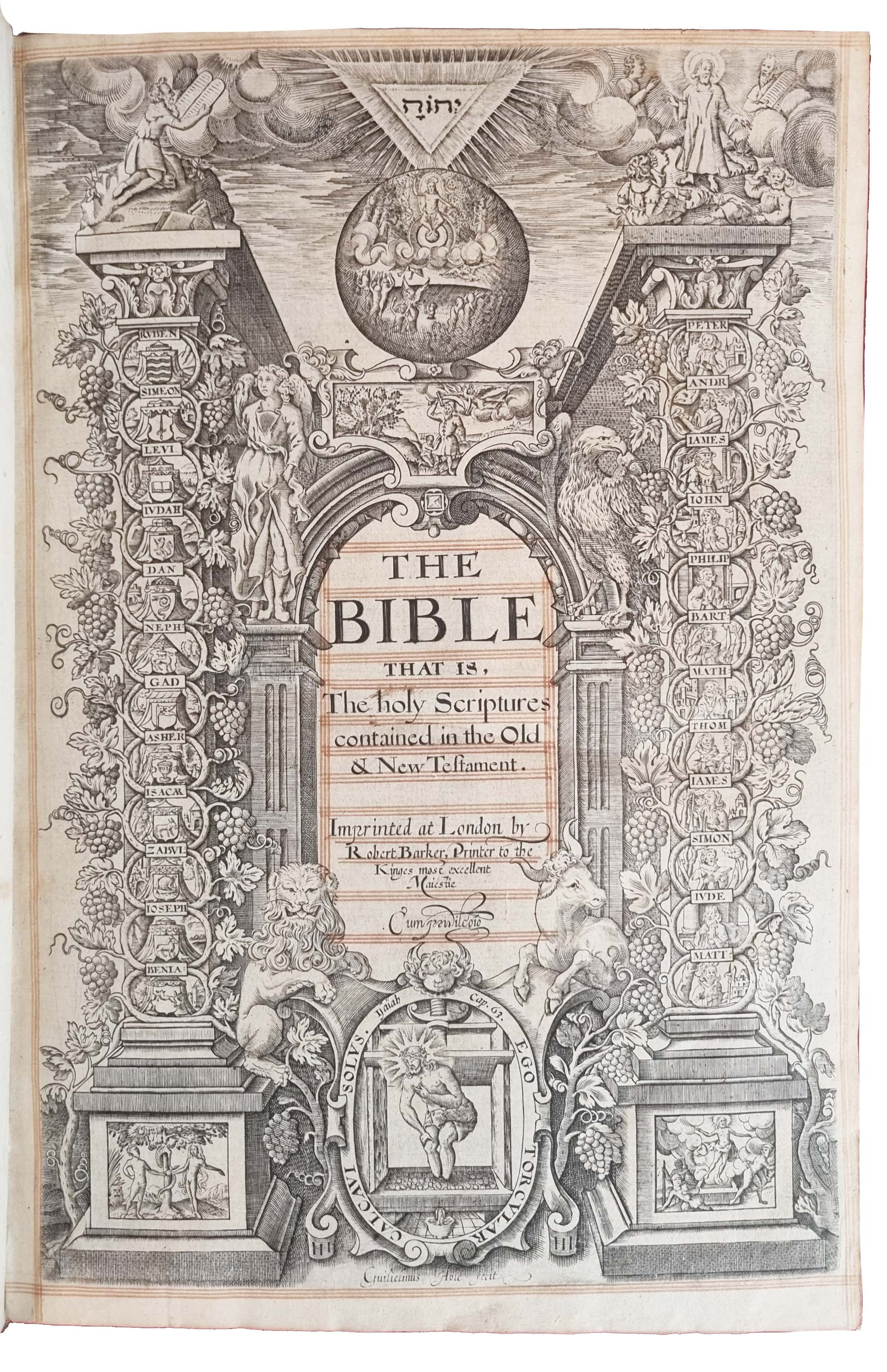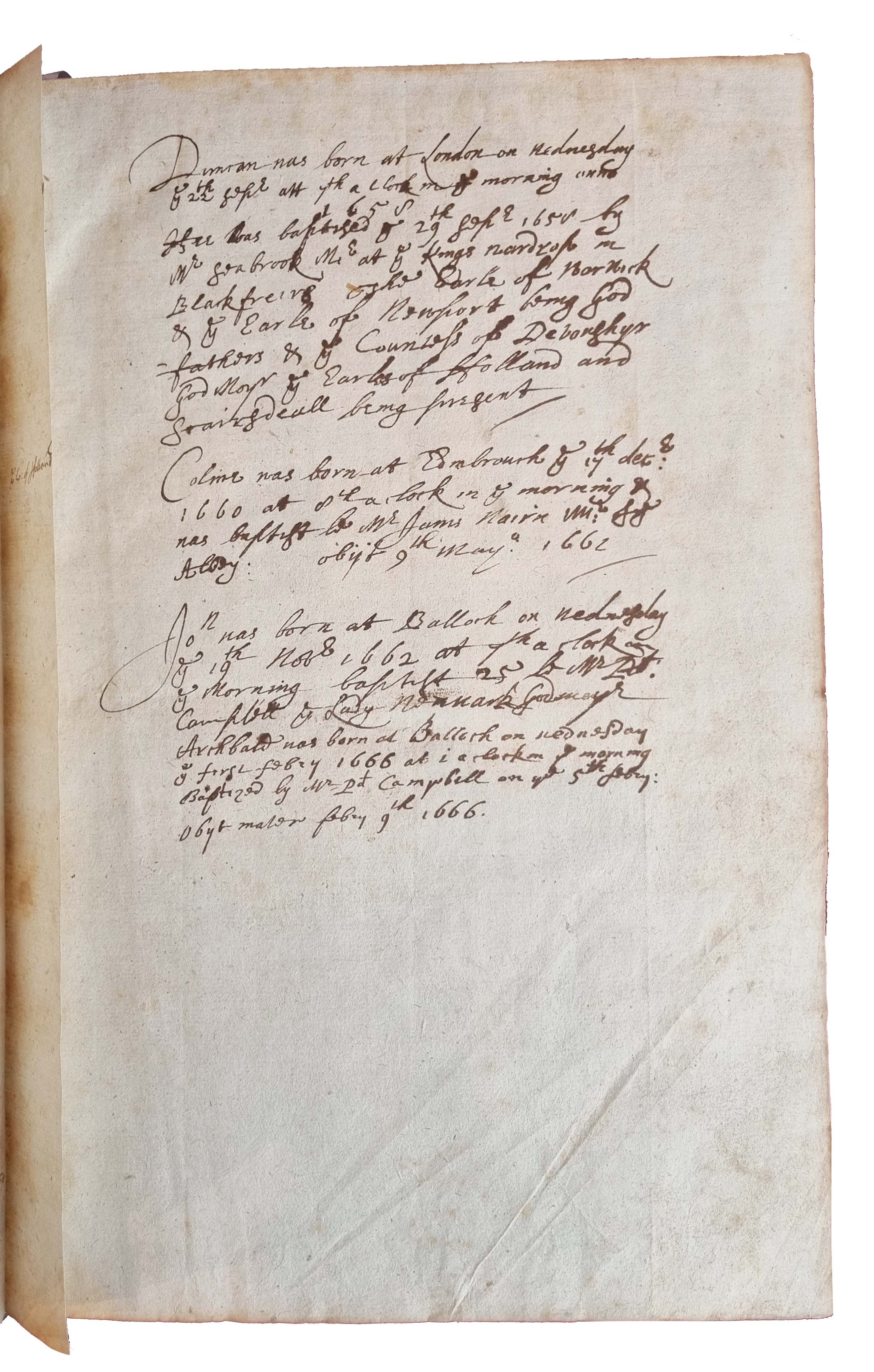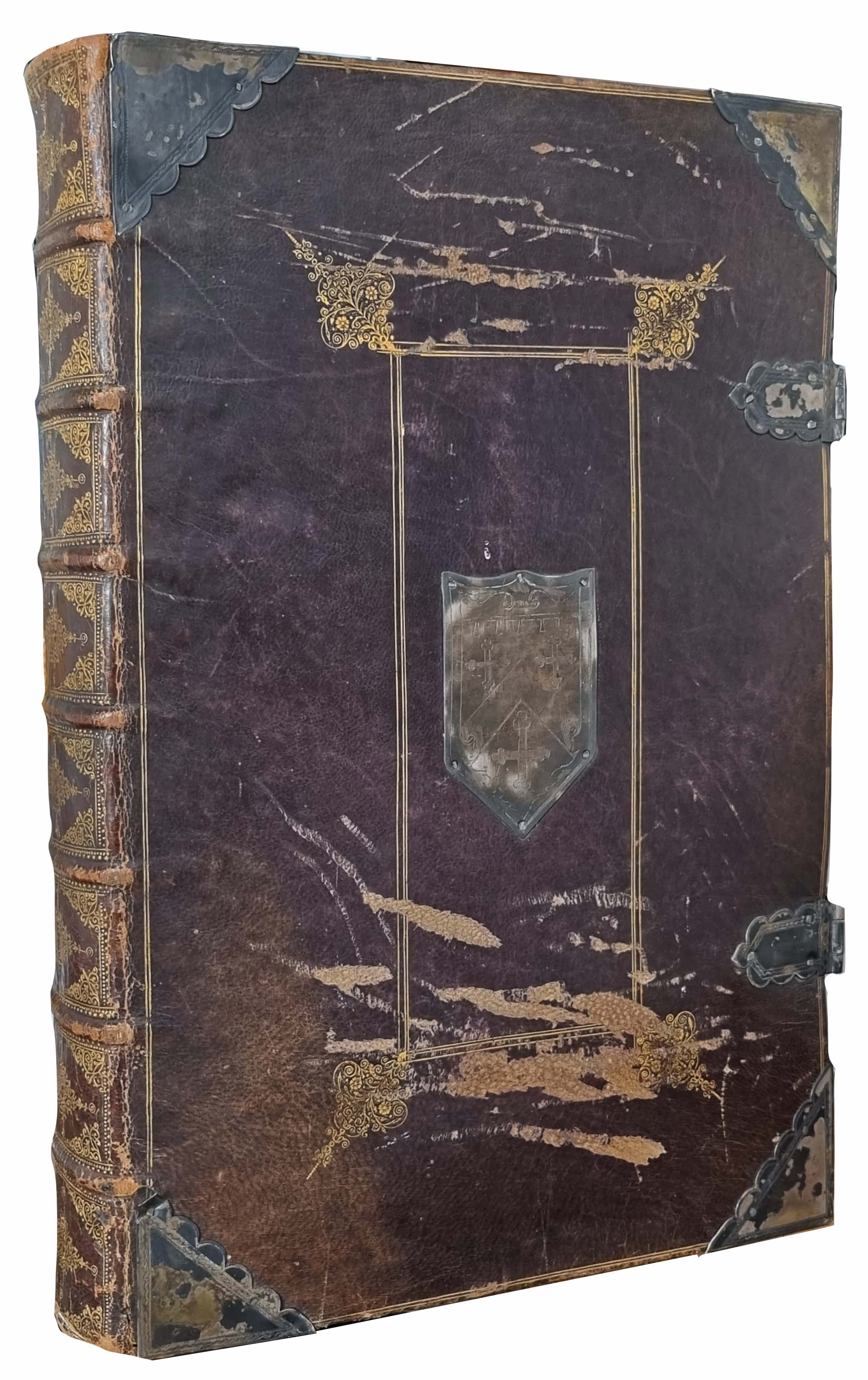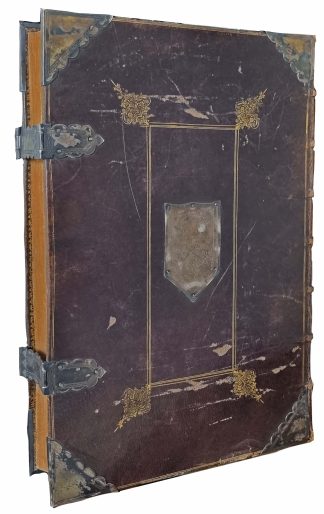BIBLE.
BOUND FOR THE 1st EARL OF BREADALBANE
The Bible, that is, the holy Scriptures. [with] The New Testament. [and] The Whole Booke of Psalmes.
London, I-II: Robert Barker, [1607]; III: for the Companie of Stationers, 1609.£8,500.00
Folio. 3 parts in 1, ff. [4], 444; 135, [7]; pp. [2], 114, [8]. Roman letter, little Italic, double or quadruple column, music notation to second, ruled in red throughout. Engraved architectural title with Moses, Christ, Tetragram, tribes of Israel, Apostles, woodcut title vignettes to Parts II and III, charming full-page woodcut, within decorated border, of the Garden of Eden to [*]3 (I), 40 1/3-page or smaller woodcut maps or scenes, decorated initials and ornaments. Slight age yellowing. An excellent, clean copy in Scottish black morocco(?) c.1660 , marbled eps, silver clasps, ‘Sr John Campbell’ engraved to reverses and cornerpieces, double gilt ruled, inner panel triple, gilt fleurons to inner corners, engraved armorial silver centrepieces, with shields of Robert Rich, 2nd Earl of Holland (front), and Walter Cope of Cope Castle (rear) to covers, raised bands, spine and edges gilt, some scratches and wear to covers. C18 engraved armorial bookplate of the Earl of Breadalbane to front pastedown, early ms shelfmarks to ffep verso, 21-line ms on family history c.1660s to fly.
The unusual presentation binding is almost certainly Scottish, though we have not traced anything similar in major bibliographies and databases. Silver furnishing is often found on devotional books with relatively simple bindings way into the C18, though the presence of engraved silver shields is very uncommon. ‘Not many fine bindings seem to have been produced in Scotland during the C17, and no more than five have been published which are certainly earlier than 1700’ (Hobson, ‘Abbey’, p.106). This binding was produced between 1657 and 1666, providing rare certainty to its dating. The presence of Lady Mary Rich’s arms (see below) suggests a ‘terminus post quem’ in 1657, the year of her marriage to Sir John Campbell. The gilt decoration is very reminiscent of early 1660s bindings in the Restoration style. In 1660, Sir John and Lady Mary were back in Edinburgh, as noted on the flyleaf. Lady Mary died in 1666, the ‘terminus ante quem’ for the binding.
The present binding was commissioned by Sir John Campbell of Glenurchy (1636-1717), 5th Baronet and 1st Earl of Breadalbane and Holland, member of the Scottish Parliament, and one of those responsible for the infamous Glencoe Massacre. His name is carved in elegant cursive on the verso of the silver clasps. He married his English wife, Lady Mary Rich (1636-66), in London in 1657. The shields on the covers portray the composite arms of Lady Mary. On the front are those of her father’s family – Henry Rich, 1st Earl of Holland, and on the back are those from her mother, Isabel Cope, heiress of Walter Cope (d.1614) of Cope Castle, Middlesex. Sir John Campbell most probably recorded the birth of his first four children on the flyleaf. In the 1650s, he contributed to Royalist uprisings in Scotland and spent time in London seeking to promote the Stuart restoration, though his support for James II and the Pretender was lukewarm. At the time of the Restoration, he was, next to the Earl of Argyll, the most prominent of the Highland nobles. ‘It has been said of Campbell that he was as cunning as a fox, wise as a serpent and slippery as an eel. On his marriage to Lady Mary Rich, […] he received as her dowry the then considerable sum of £10,000, which was paid in coin and placed on the back of a strong gelding, guarded on each side by a well-armed, sturdy Highlander from London to Breadalbane’ (Lee, p.40). His son Duncan was born in London in 1658. Colme (Colin) was born in Edinburgh in 1660, where he was baptised by Rev. James Nairn, probably the major bibliophile (1629-78) who left his book collection to Edinburgh University; Colin only lived two years. John (later 2nd Earl) and Archibald were born at Balloch, near Loch Lomond, seat of the Colquhoun baronets. Lady Mary died of childbirth four days later, in 1666, which Sir John recorded as ‘obijt mater’ (‘the mother died’). His engraved bookplate was added c.1702.
This is the Geneva version, with Tomson’s Revised New Testament, and Junius’s Revelation. This copy includes a 1609 edition of the metrical psalms.
ESTC S122320; STC (2nd ed.), 2199; Darlow & Moule 222. H. Lee, History of the Campbell Family (1920); W. Mitchell, A History of Scottish Bookbinding (1955); E. Gordon Duff, ‘Scottish Bookbinding, Armorial and Artistic’, The Library, 1 (1917), pp. 95-113. Many thanks to David Pearson for discussing this binding with us.

